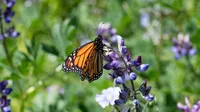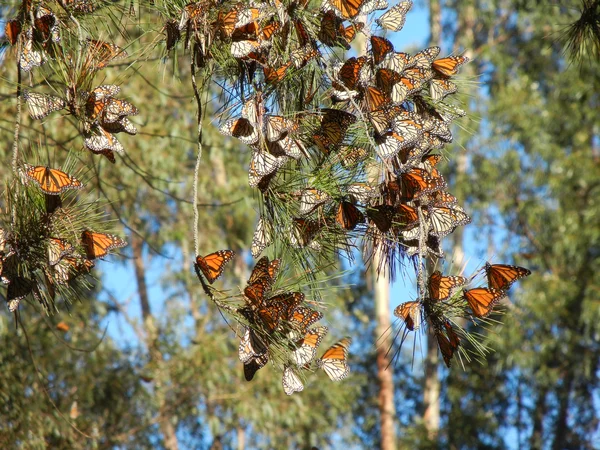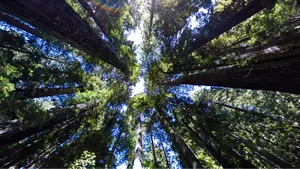Helping California’s monarch butterflies: an update

Migratory monarch butterflies face rising threats, and they were recently listed as endangered on the International Union for Conservation of Nature’s Red List. In 2021, we shared our intention (alongside Google.org) to restore and enhance habitat for monarchs and other pollinators across California, including creating more habitat on our own campuses.
We’ve seen promising early results from these efforts. Over the past year, we’ve helped restore and enhance more than 500 acres of habitat across California. We also measured strong increases in the presence of monarch eggs, caterpillars and butterflies at our campus project sites.
There’s still a long way to go. But by sharing more about our work to help both people and nature flourish in the campus and communities we call home, we hope to inspire others to take action.
Planting milkweed to attract monarchs
Since 2021, Google’s real estate team has completed more than 35 monarch habitat projects on our California campuses, totalling roughly nine acres of new and enhanced habitat. The completed projects were installed primarily on our Mountain View and Sunnyvale campuses, as well as in Palo Alto, Santa Barbara and Los Angeles. We continue to maintain and refresh the plantings as needed.
Project sites — ranging from just a few hundred square feet to nearly an acre — take the form of native pollinator gardens woven into our campuses. We've used the best available science to create the right mix of milkweed plants, which support monarch eggs and caterpillars, and flowers, which support butterflies passing through on their long migration. In total, we planted over 4,400 milkweed plants — enough to fill an Olympic-size swimming pool.
After a year of monthly monitoring trips to measure monarch activity at habitat project sites and control sites (areas without new monarch-related plantings) in Mountain View and Sunnyvale, we’ve seen clear signs of success. On average, when comparing habitat project sites with control sites, the presence of monarch eggs was roughly 6 times greater and of caterpillars roughly 10 times greater, and there were measurably more monarch butterflies as well.
In the past year, we’ve measured increases in the presence of monarch caterpillars on our campuses, like this one crawling on milkweed in Mountain View. (Rick Miskiv for Google)
We’ve also seen increases in monarch eggs, like this one near a Google building in Sunnyvale. (Rick Miskiv for Google)
And we’ve found measurably more adult monarch butterflies near our campus habitat projects compared to other sites. (Rick Miskiv for Google)
By far the most important factor was the presence of native milkweed — the more milkweed, the more monarchs. We also found a modest increase in the number of butterflies at sites with more native plants and higher shrub cover. Butterflies need milkweed to lay eggs, but they also consume nectar from flowers, and these results highlight the importance of planting native flowering plants alongside milkweed when creating monarch habitat.
The takeaway is a hopeful one: if you create the right monarch habitat, even in small patches, then monarchs will find it.
Supporting partners to broaden the impact
Beyond our own campus work, Google.org made grants to the Xerces Society and Peninsula Open Space Trust (POST) to help protect and restore hundreds of acres of additional monarch habitat.
Since the start of 2022, Xerces has restored over 500 acres of monarch habitat across California, including planting nearly 9,000 native milkweed plants and more than 32,000 total monarch-friendly plants. Xerces partnered with underserved communities to create smaller-scale habitat projects on schools and urban farms. Xerces is also working with the U.S. Fish and Wildlife Service to help monitor the western monarch population at sites where they spend the winter.
In collaboration with the Santa Clara Valley Open Space Authority and Point Blue's Students and Teachers Restoring A Watershed (STRAW) program, POST has created four habitat areas and conducted several “planting days” with school students to install more than 500 native plants, which will be irrigated through a solar-powered pump. POST plans to plant 10 habitat areas that are each roughly 1,200 square feet throughout the spring and summer, and to monitor pollinator activity in these areas over the next year.
We’ve enhanced monarch habitat in the Crittenden pollinator garden outside a Google building at 1400 Crittenden Lane. (Rick Miskiv for Google)
A monarch butterfly lands on a native yarrow plant at the Crittenden pollinator garden. (Rick Miskiv for Google)
Monarch habitat at Charleston East includes milkweed, Cleveland sage and native bunch grasses. (Rick Miskiv for Google)
A monarch butterfly drinks nectar from a Cleveland sage flower at Charleston East. (Rick Miskiv for Google)
Our monarch habitat attracts many pollinators, including this native bumblebee collecting pollen from a lupine flower. (Rick Miskiv for Google)
Additionally, Google provided a grant to the City of Mountain View so they could create and maintain pollinator habitat at Shoreline Park. Based on the success of an initial site, the City is developing a second one, working with more than 40 volunteers to prepare the area. Planting at the site will continue through the spring and feature more than 150 native plants, including milkweed and other flowers.
Monarch butterflies face a long road to recovery, and it will take broad, collective action to get there. We’re hopeful that by doing our part and supporting partners, we can expand our impact and provide a model for creating habitat for this struggling — yet iconic and inspiring — species to thrive.








